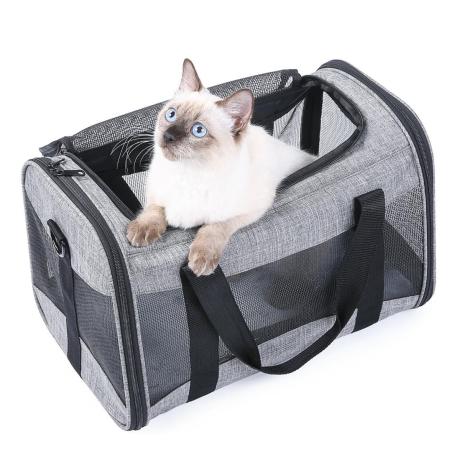
BCAH is very proud to announce that our entire staff became Fear Free certified in 2018!Fear Free was founded in 2016 by veterinarian Dr. Marty Becker, an advocate for the human-animal bond. Fear Free's mission is to prevent and alleviate fear, anxiety, and stress in pets by inspiring and educating the people who care for them.
Fear Free developed courses written by the most respected veterinary and pet experts in the world. Every BCAH staff member took 9 hours of special training to become Fear Free certified so your pets can have less stressful visits with us. Each year since 2018, the staff has taken additional continuing education courses to enhance their Fear Free knowledge and to remain certified.
Our blog will have a series of articles to educate our clients in the Fear Free principles.
Part 1: Good veterinary visits begin at home: the cat
Particularly In the cat patient, reducing the pet, client, and vet team stress starts at home. The carrier should be top-loading and come apart easily so the top can be removed. There is nothing worse than starting the vet visit by dragging a cat out of a carrier! It is far better to remove the top of the carrier to gain access to the cat. Most cats can be examined while lying in their carrier on their favorite bedding, at least for the majority of the examination.
The carrier should not be hidden away and brought out only for vet visits! At home, the carrier should be left out in a favorite resting place with the top off. Bedding should be placed inside to make it soft and comfortable. A calming feline pheromone spray (our vets recommend Feliway) should be sprayed on the bedding now and again. The owner should feed the cat or leave treats near the carrier. Keeping the carrier near a heat source, sunshine or a
window may also make it more acceptable. Using catnip, playing with a favorite toy near or in the carrier, or placing a scratching post near the carrier can also help. The overall goal is to make the carrier a safe and familiar place for the cat.
On the day of the appointment, spray the carrier bedding and car with a pheromone spray 20-30 minutes before leaving. Place the cat in the carrier, put the cover on and then use a towel to cover the entire carrier to block visual stimuli. Prepare the car by getting it to a comfortable temperature, put on calming soft music to block out sounds that might frighten the cat, then load the cat carrier into the car. The carrier should be carried in your arms, not by the handle, which makes it swing and causes the cat to feel unstable. Don’t carry or swing it like a suitcase! The safest location for the carrier is on the floor behind the passenger seat so it doesn’t slip and slide and scare the cat. By the way, don’t feed your cat just prior to the visit. It is better to bring a hungry cat so the vet team’s special treats will be more likely to entice and distract your cat from the exam and other medical procedures!
Once you have arrived at the vet, call the office from the car to be sure the exam room is ready for the cat. If possible, avoid the waiting room, especially if it is shared with dog patients. If the waiting room is unavoidable, keep the towel over the carrier and place the carrier as high as you can—on a seat or your lap, not on the floor. Cats like high places and don’t like to have dogs sniffing the carrier!
If the visit does not go smoothly, ask your vet for pointers to improve the next visit. It is possible that your cat could benefit from medication given at home a few hours prior to the vet visit to help alleviate anxiety and stress.
Believe it or not, the return home can also cause stress to your cat. The cat may smell like the clinic. Therefore, other cats or dogs in the home may either avoid it or attack it. The cat may feel sedated or sick. In general, it is best to have a sanctuary room at home where the cat patient can be left alone to relax and adjust until it is feeling better and more alert. Mask the scent of the clinic with pheromone spray or by rubbing a piece of your clothing on the cat to make it smell more familiar. Distract other pets by playing with them or giving them special treats.
I hope this blog gave you concrete steps to minimize fear, anxiety and stress in your feline friends when they need to visit the vet. Cats are exquisitely good at masking illness, so regular vet visits are essential for long and healthy lives. Following the Fear Free principles should make veterinary visits easier for your feline friend.
Stay tuned for ideas to make your canine friends’ visits easier too!